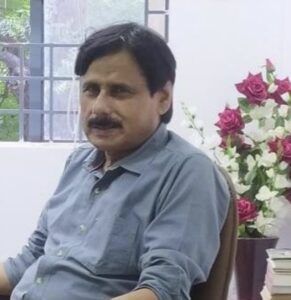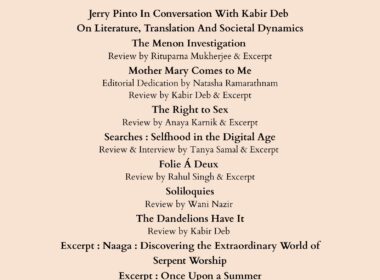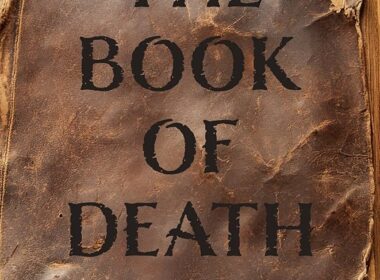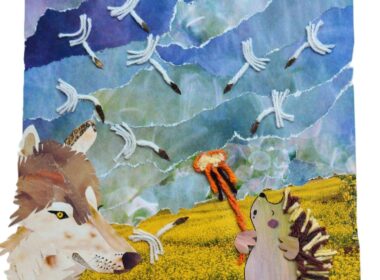In Conversation with Khalid Jawed on The Book of Death
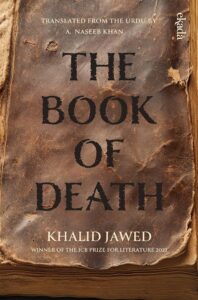
Image Courtesy of Westland Books
Rituparna Mukherjee : Congratulations Khalid Sahab on the release of your novel The Book of Death. I had a really great time going through it. For a slim novel, the book is quite a heavy read. How did you conceive of the thematic and structural layout of the book, seeing that the novel itself is a tale within a tale?
Khalid Jawed : Thank you for your kind wishes, your generous reading of the novel, and thoughtful observations. Before the novel, I wrote long stories. Over time, I felt drawn to minimalism, to implication, and to how large, complex emotions can inhabit small spaces. The Book of Death began unpremeditated, organic and intuitive, without a conscious design. I begin writing at noon when the world feels suspended and everything seems briefly balanced between motion and stillness, in what Nietzsche calls the noon-tide, the lucid hour of decision and affirmation. For me, it’s the pristine hour for creation. I began it one noon and completed the novel in a single forty-day stretch. Its slimness was an artistic choice rather than a constraint, so that the raw emotional truth could speak plainly, without ornament. The structure wasn’t forced. It grew as the theme developed, allowing the prose to carry what is hard and uncomfortable to face. The tale within a tale felt less a device than a necessity. We all live with two stories, the one we display and the one we guard. The outer narrative, the stable, visible world, becomes a steady, lived frame, while the inner story works as a quiet confession beneath it. As the voices move together, each alters the other, the narrator shaping the tale, the tale reshaping the narrator.
RM: Keeping the final chapter a complete blank, seems like an interesting narrative strategy refusing, as life often does, to give a closure. What did you have in mind while conceiving of this format?
KJ: It was a deliberate choice to leave the final chapter blank in order to mirror life’s inherent uncertainty. While we crave the consolation of a tidy ending yet life rarely grants us a neat closure. An open ending allows the readers to step into the silence, to question, feel the weight of the unresolved, and finish the story within their own imagination. But the blank space isn’t absence. It’s a living pause where meaning continues to unfold beyond the confines of the page, as also a resistance to the comforting illusion of finality, suggesting that every ending is a nascent beginning. Like most of us, I believe that life doesn’t conclude in punctuation and full stop but in enduring continuation.
RM: As the title itself suggests, the book is a philosophical rumination on death as a life event. I was especially intrigued by your conception of suicide in this text, as a constant companion, a shadow, a being with a visceral presence, but never viewed with animus as moral texts often condition us to do. What are your thoughts on death and our agency over it?
KJ: What a perceptive reading! To me, death, and indeed suicide, are not crude intrusions into life, but presences that coexist alongside it. Death is not life’s opposite, rather it’s woven into the its fabric. There is a profound irony in how we live our life: we live pretending that death is elsewhere, all the while, it walks silently beside us. In approaching the suicide within the novel, my intention was neither to moralise nor to romanticise. I intended to acknowledge its visceral reality and treat it with the gravity it demands. I believe our true agency in the face of mortality lies not in seeking its embrace, but in recognising it as the fundamental boundary that gives shape and meaning to life itself. To look upon death without reflexive fear and hatred is to see life itself more truthfully. This awareness can make us more alert to existence, and crucially, more compassionate in the face of despair. So, suicide and death in my novel aren’t a full stop. They are silent companions, reminding us that to live fully is to live in conversation with our own ending. Frankly, I believe birth already contains the predicate of suicide. To be born is to enter a trajectory that ends in death; knowing this, coming into being is a self-willed step toward one’s own vanishing.
RM: I might run the risk of reading too much into it, but I was quite taken with your use of the name “Girgita Til Mas” for the fictitious setting of the novel. Is the use of ‘Girgit’, a chameleon, your way of highlighting the human tendency for masking in social life? Have you directed this novel to address the culture that breeds and conditions us? And that only a person who knows himself as well as the protagonist does, and is repelled by that knowledge, can dispense with the formalities of this masquerade? I would love to hear your thoughts about this matter.
KJ: The name Girgita Til Mas is, as you perceive, deeply deliberate. ‘Girgit’, the chameleon, embodies the human instinct to adapt, conceal and perform. The town itself became a kind of mirror, a place where inhabitants reflexively assume the hue the moment demands, where truth is not absent so much as perpetually in disguise. In that sense, the novel speaks to a culture that cultivates and breeds performance, training us from our childhood compliance and conformity. As a result, we grow up mastering the art of blending in, until authenticity itself feels perilous. To know oneself too clearly is to become estranged from the world’s masquerade. My protagonist’s revolt is not loud. It’s internal, almost spiritual, the quiet rebellion of someone who has seen through the painted surface and cannot unsee it. Thus, Girgita Til Mas is as much a psychological state as a physical place, a landscape of masks. But my intention is less to condemn the society than to articulate the particular ache of consciousness within it.
RM: Although the novel is an intensely personal take on the violence of living and tries to separate death from its moral and societal entrapments, I also found it deeply symbolic of the reflexive human tendencies for self-destruction that is prefaced in the outer shell of this text. Why was it so important for you to ingeniously introduce the self-wrought ecological disaster we are inevitably pushing ourselves towards?
KJ: The ecological ruin and desolation in the novel is far more than setting; it is an extension of the human psyche, a manifestation of the same impulses that drive the individual self-destruction. I have long held that the violence we inflict upon nature is a precise mirror of the violence we harbour within. To exhaust the earth is to externalise our own decay, to project our inner turmoil onto the very landscape. This self-wrought collapse served to dissolve the boundary between personal and collective extinction. The protagonist’s crisis is not isolated; it is symptomatic of a species profoundly out of harmony with existence. His despair, defiance and attraction to the void and death, all of these echo a broader human condition in which progress is often a guise for ruin. My aim is not to moralise, but to allow the environmental decay to emerge organically from the same spiritual exhaustion that afflicts the characters and that govern human life in the novel. As the individual corrodes from within, so too does the planet wither from our collective blindness. The ecological imagery, therefore, stands as a metaphor for our shared mortality, a silent testament that all acts of self-destruction, personal or planetary, spring from the same estrangement: our failure to live gently with ourselves, with one another, and with the world that cradles and sustains us.
RM: There is a very interesting progression of disgust in this book, from dehumanizing oneself by constant animalization, the rotting external circumstances that converge to intense self-disgust by the time the novel ends. How have you managed to write so lyrically about disgust, especially in Urdu, a language that is vastly associated with poetry, romance and beauty? What is your personal take on disgust and its necessity in literature especially while you are dealing truthfully about love, life and relationships?
KJ: Your question touches the very core of my aspirations and endeavours. True, Urdu is often celebrated as a language of romance, refinement and beauty, yet I find its true strength in a latent tension – its capacity to hold the unbearable, such as decay, shame and disgust, within its graceful contours. I sought to test this elasticity to see if the language could encompass the grotesque without forsaking its inherent music and rhythm. For me, disgust is not a negation of life but its raw undercurrent, the point where beauty falters and a starker truth appears. The dystopian and the apocalyptic compel me because they sharpen vision. Through them I read suffering and melancholy with greater honesty. In classical Sanskrit aesthetics, this is the realm of Vibhatsa rasa – disgust and revulsion not as spectacle, but as a disciplined seeing that clarifies and illuminates. Held rightly, Vibhatsa becomes a razor that clips illusion, leaving the core of experience bare. To write truthfully of love or tenderness is to inevitably encounter disgust, for profound intimacy demands that we confront all that repels – the body’s decay, the limits of the flesh, the corruption of pure desire. Disgust strips our ideals bare, compelling us to regard the self without ornament. To treat it lyrically was an attempt to restore a certain dignity to that what is considered abject. In Urdu, I discovered that disgust need not be coarse; it can be rendered through rhythm and imagery that simultaneously attracts and repulses the reader to turn a wound into a mirror, reflecting both pain and a terrible beauty. Thus, disgust holds a moral and aesthetic necessity; it is the acid that cleanses illusion and demands honesty. Any portrait of love or life that avoids it may be polished, but it remains, fundamentally, a lie. The lyricism, then, was not an act of mitigation, but of revelation to show that within decay itself resides a strange, tremulous beauty, the final proof of a responsive life.
RM: Writing about violence, even its intense suffocation, is not something new, what is new, however, is the very visceral and honest way you present it, such that it occupies an entire narrative—a text of progressive mental violence that proceeds from physical and cultural violence. The relentless and disillusioning nature of it in the book especially reminded me of the writings of Samuel Beckett and Tom Stoppard. Who do you consider your literary mentors?
KJ: First of all, my deepest gratitude to the quiet Muse who guided this novel. It may sound odd to say, but I’ve never had a strong predilection for drama; Beckett and Tom Stoppard, for all their brilliance, have simply not spoken to me as powerfully as others. The writers from whom I drew my sustenance for my fiction are Fyodor Dostoevsky, Franz Kafka, Tarjei Vesaas, Pär Lagerkvis, Juan Rulpho, Gao Xingjian, Roberto Bolano, Jon Fosse, and several other Scandinavian and Swedish writers; from our part of the world, O. V. Vijayan, Nirmal Verma, Udayan Vajpeyi and Abdullah Husain. They taught me that violence need not scream: it can live in silence, in repetition, in the exhaustion of language. Their books showed me how despair can be stripped of drama and faced as a simple condition of being; they also opened my eyes to the playfulness of intellect, to how philosophy and absurdity can share the same breath. My favourite writers, then, are those who look unflinchingly at the human condition and dare to speak of hunger, death—even filth and refuse. Each, in a different way, explores the fracture between morality and survival, the ache of consciousness, and the strange beauty of brokenness. From them I learned that the deepest violence is often inward—lodged in memory, silence, and the failure to connect. Beyond names, my true favourite writers are those who taught me the art of gazing into the human abyss: that literature’s task is not to soothe but to wound truthfully—to touch where it hurts and, within that pain, offer a fleeting clarity.
RM: All writing is political. What would you say is your own politics of writing? What are you working on at present that we can look forward to reading in future?
KJ: All writing is political, not in partisan slogans or ideology, but in the choices of what we see and what we name. Every word is an ethical decision – revelation, omission and confrontation. My work begins with a politics of honesty, a commitment to look at the world and the self without disguise. I believe I am drawn to a politics of interiority – to the unseen terrains of shame, memory, violence, tenderness, and the silences that shape a life. My works, I think, consciously refuse sentimentality and dogma. The aim is not to instruct but to unsettle and disturb comfortable assumptions. If my writing has a stance, it lies in it that truth is complex, empathy is radical, ambiguity is moral, and language must resist the simplifying narratives of our time. Formally, I work in fragments rather than linear plots—spaces where memory, confession, and myth intersect. The translation of my latest Urdu novel Arsalan aur Bahzad is forthcoming…
Khalid Jawed is one of the leading Urdu novelists today. He is the author of fifteen works of fiction and non-fiction, and is a recipient of the Katha Award, the Upendranath Ashk Award and the UP Urdu Academy Award. He is a professor at Jamia Millia Islamia University. Khalid Jawed was awarded the JCB Prize for Literature (2022) for the English translation The Paradise of Food of his book Ne’mat Khana.
